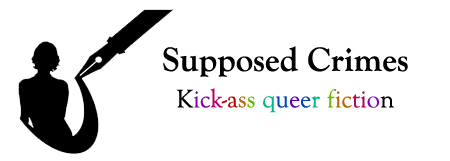
Both YouTube and the world of books have a common problem: Labeling, warning, and filtering media for the inclusion of LGBTQIA+ content.
You read that right. We're not talking about sexually explicit material. The mere appearance of something flagged as LGBTQIA+ is enough to earn a content warning as "mature." Meanwhile, Disney Princesses continue to smooch their Prince Charmings and YouTubers promoting heterosexuality can share their wisdom about vibrators unrestricted.
Aside from the generalized ignorance that being LGBTQIA+ is somehow all about what folks do in bed, this has much more serious implications. In particular, if LGBTQIA+ content is filtered out and warned for, it makes it that much harder for young people and those who are newly out to find what they need.
With regard to slapping a label on books, there are three facets to the issue. First, not all books with LGBTQIA+ content, regardless of target audience, are explicit. They're not even all romance. Some contain religious themes and characters, which are ideal in particular for folks who still practice their faith and need reassurance that it's all right to be both spiritual and LGBTQIA+. There are also just as many LGBTQIA+ sweet romances (i.e., no sex on page) as there are ones with detailed sexual content.
Second, young people are already reading books with mature sexual content in them. This may come as a shock to some people, but plenty of kids raid their parents' bookshelves and discover the wide world of "mature themes" with heterosexual, cisgender couples. It's a mistake to assume that teens are delicate, virginal flowers who have never read a sexy book before. Yet somehow, this fact never comes up when deciding to limit access to LGBTQIA+ books.
Third, why are we not worried that kids are being exposed to violent content? A shocking number of books on schools' required reading lists contain horrific brutality. One question we should be asking ourselves: If we feel completely comfortable having our kids read The Outsiders and Lord of the Flies (both known for explicit violence), why do we feel uncomfortable having them read Rainbow Boys or Ash (classic gay & lesbian YA novels)?
Books are one of the ways in which youth explore ideas and develop a sense of themselves and their place in the world. For teens who are questioning or already understand themselves as LGBTQIA+, literature can help them process the complexities. For those who don't identify that way, books can foster a sense of understanding and promote empathy. Novels with a wide range of healthy sexual expression (and I'm including all forms that takes here, not just monogamous, vanilla couplehood) can be informative and educational, even if they're not specifically intended as such and even if the sex is non-explicit.
LGBTQIA+-themed books should be included in the push for diverse, #OwnVoices literature in school curricula. But at the very least, we need to stop labeling the content as "mature" and begin seeing these books for what they are: no more or less than stories about the infinite ways there are to be human.
